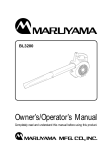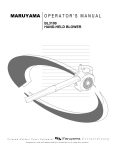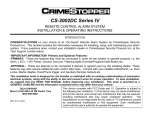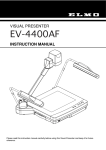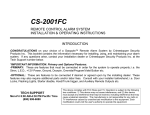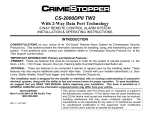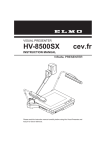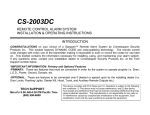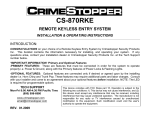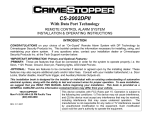Download CrimeStopper SP-100 Operating instructions
Transcript
SP-100 REMOTE CONTROL ALARM SYSTEM INSTALLATION & OPERATING INSTRUCTIONS INTRODUCTION CONGRATULATIONS on your choice of a “Security Plus” Remote Alarm System by Crimestopper Security Products Inc. This booklet contains the information necessary for installing, using, and maintaining your alarm system. If any questions arise, contact your installation dealer or Crimestopper Security Products Inc. at the Tech Support number below. This installation book is designed for the installer or individual with an existing understanding of automotive electrical systems, along with the ability to test and connect wires for proper operation. To ease installation, we suggest that you READ THIS MANUAL before beginning your installation. This book is provided as a GENERAL GUIDLINE and the information contained herein may differ from your vehicle. TECH SUPPORT Mon-Fri 8:00 AM-4:30 PM Pacific Time www.crimestopper.com Phone (800) 998-6880 FAX (805) 581-9500 This device complies with FCC Rules part 15. Operation is subject to the following two conditions: 1) This device may not cause interference, and (2) this device must accept any interference that may be received, including interference that may cause undesired operation. The manufacturer is not responsible for any radio or TV interference caused by unauthorized modification to this equipment. Such modification could void the user's authority to operate the equipment. REV. B 02.2009 1 TABLE OF CONTENTS Installation Cautions & Warnings…….………………………………………………………….……….…….……2 Control Module & Component Mounting…………….………………………..…………………..….….…….…..3 Wiring……..……………………………………………………………………………………………………...…….4-5 Power Door Lock Wiring...…………………………………………………….………..………………….…………6 Transmitter Programming…………………………………………………………………………………….………7 Option Programming………………………………………….………………………………..………………….8-10 Operating Instructions………………………..……………………………………………………..……..…….11-13 Car Jack Protection…………………………………………………………….…………..…….……..……………14 LED / Valet Switch……………………………………………………………………….………………..…..………15 Shock Sensor……...…………………………………………………………………………..…………..…..………15 System Wiring Diagram……………………………………………………………………………………...………16 INSTALLATION CAUTIONS & WARNINGS BEFORE BEGINNING, check all vehicle manufacturer cautions and warnings regarding electrical service (AIR BAGS, ABS BRAKES, ENGINE COMPUTERS, BATTERY etc.). WE RECOMMEND the use of a VOLT/OHM METER to test and verify wiring circuits. Test lights or illuminated probes can cause damage to on-board computer or engine management systems. DO NOT exceed maximum output ratings or damage may occur. Electrical current limits for this alarm are listed where applicable on the system diagram (Pg. 16). If you are unsure about the current load, of a specific circuit on your vehicle, measure the load first with an amp-meter before connecting. WE RECOMMEND that the MAIN SYSTEM FUSE be REMOVED before jump starting, using a battery charger, or changing the battery. A voltage surge or high boost condition could damage alarm circuits. DO NOT ROUTE ANY WIRING THAT MAY BECOME ENTANGLED with brake, and gas pedals, steering column, or any other moving parts in the vehicle. 2 CONTROL MODULE MOUNTING DO NOT Mount the control unit in the engine compartment! DO NOT Mount the control unit or wiring harness where they can become entangled with moving parts such as brake/gas/clutch pedals, or the steering column! The alarm control module should be mounted in a concealed location. The Placement of the module will affect the distance from which the remote transmitter can control the unit. The antenna wire should be routed away from any metal if possible. Do not alter the length of the antenna wire or route it with other wires. Do not ground the antenna wire. Fasten the module to a bracket or wire harness using the cable ties provided. Underdash Mounting: If you are locating the control unit underdash, mount it as high as possible, not easily located by an intruder. Driver’s Side Underdash mounting provides an easy location for wiring most of the system’s connections, however this is a common location for an intruder to check for an alarm after breaking into the vehicle. The left side of the vehicle may contain more metal and or wiring that will create interference and decrease the operating range of the system. Passenger Side underdash is a good location, however some extra wiring may be needed to extend wires across from the driver’s side. Under-seat / Center Console mounting is also a possibility, but NOT RECOMMENDED. The system’s transmitter range will be reduced by the metal structures of the seat or center console and the unit may also be exposed to moisture from spilled drinks etc. Moisture or water damage is not covered under the warranty and will be subject to repair charges. Under seat or console mounting will create more difficulty if you need to access the unit for service or want to add-on features or connections later. Use this location as a last resort. COMPONENT MOUNTING SIREN: Mount the siren under the hood to an inner fender-well or other body surface with the open end facing downward. SHOCK SENSOR: Mount the included shock sensor with wire ties to an under dash wire harness or fasten with screws to firewall or side paneling. Use the adjustment screw to set the sensitivity of the sensor. LED: Mount the LED status indicator in a visible location on the dashboard or console. VALET OVERRIDE PROGRAM BUTTON: Mount the Valet/Override/Program push-button in a hidden but accessible location. It is REQUIRED for emergency disarm, programming, and Valet Mode. 3 WIRING GREEN WIRE: (-) DOOR TRIGGER Identify the wire that reads ground when any door is open and 12 volts when all doors are closed. Some vehicles may have isolated door triggers. In this case you may need to run additional wires from other doors or go directly to the wire that triggers the vehicle’s interior dome light. One vehicle will not require the use of BOTH door trigger wires. PURPLE WIRE: (+) DOOR TRIGGER Same as the GREEN wire above except this wire is used for vehicles that show a positive voltage (12 volts) when the door is open and a ground when doors are closed as in many Ford, Lincoln, and Mercury vehicles. YELLOW WIRE: IGNITION SWITCHED “ ON ” AND “ START ” 12 VOLTS Connect to an IGNITION wire (or fuse in the fuse box) that shows 12 Volts when the key in both “ON” and “START” positions. BLACK WIRE: SYSTEM CHASSIS GROUND The Black wire MUST be connected the CHASSIS METAL of the vehicle. Scrape away any paint or debris from the connection point and use a star washer to ensure a good connection. Keep the ground wire short. GRAY WIRE: (-) AUX REMOTE OUTPUT 1 (Optional, may require a relay) Connect to the Negative trunk release circuit or to the activation circuit of an auxiliary module or device. If the circuit requires 12V, then a relay is required. RELAY WIRING: Connect the Gray wire to terminal 85, connect relay terminals 86 and 87 to 12V constant power. Connect terminal 30 of the relay to the 12V positive device/circuit to be activated. BLUE WIRE: (-) HOOD/TRUNK TRIGGER Input trigger for a grounding hood or trunk pin switch. Connect to existing hood and trunk pin switches that read ground when open. If no existing switches are available, install new pin switches if desired. Note: DO NOT mount new pin switches in water pathways. BROWN WHITE WIRE: (-) HORN PULSE OUTPUT (Optional, may require a relay) Connect to the Negative Horn Trigger wire usually located near the steering column. If the vehicle horn circuit requires 12V, then a relay is required. RELAY WIRING: Connect the Brown/White wire to terminal 85, connect relay terminals 86 and 87 to 12V constant power. Connect terminal 30 of the relay to the 12V positive device/circuit to be activated. 4 WIRING ORANGE WIRE: (-) NEGATIVE ARMED OUTPUT / STARTER DISABLE (500mA Ground, Optional) This wire becomes a (-) Ground Output when the System is Armed. This output is used for disabling the starter or to activate optional devices such as extra sensors, LED’s, window roll-up modules, voice modules etc. For Starter Kill, cut starter wire and connect between 87A and 30 on relay. Connect orange wire to 85 and connect 86 to an Ignition source that has voltage in the ON and CRANKING position. (See wiring diagram for relay configuration page 16) BROWN WIRE: (+) SIREN OUTPUT (3 Amp Max.) Connect to RED siren wire from the Siren in the engine compartment. WHITE WIRE: Two 12V FLASHING LIGHT OUTPUTS (7.5 Amp x 2) Connect to the switched parking light wire at back of light switch. If this is not possible, connect directly to one of the parking lights at the front of the vehicle. Some vehicles require separate right and left circuits. Use the one White wire for each circuit (Use separate 7.5Amp fuse for each circuit). RED WIRE: 12V POWER INPUT (15 amp fuse) Connect to 12 Volt source with supplied fuse & holder. Recommended location for this connection is at the vehicle battery positive terminal. 2 PIN PLUG (WHITE): VALET PROGRAM and OVERRIDE PUSH-BUTTON 2 PIN PLUG (RED): ALARM STATUS LED INDICATOR 4 PIN SENSOR PLUG (RED): SHOCK SENSOR: The sensor supplied with this system does not require any additional wiring. Simply mount the sensor in a suitable location, plug it in, and adjust the sensitivity. GREEN Wire: Negative Trigger. WHITE Wire: Negative Warn-A-Way. BLACK Wire: Sensor Ground. RED Wire: Sensor 12V Power. SENSOR ADJUSTMENT Clockwise = Higher Sensitivity Counter Clockwise = Lower Sensitivity 5 POWER DOOR LOCK WIRING GREEN WHITE: (-) Negative LOCK Pulse, BLUE WHITE: (-) Negative UNLOCK Pulse NEGATIVE TRIGGER DOORLOCK WIRING POSITIVE TRIGGER DOORLOCK WIRING GREEN WHITE GREEN WHITE BLUE WHITE BLUE WHITE FUSED +12V + 85 86 87 87A 30 FACTORY POWER LOCKING RELAYS L UL 85 86 87 87A 30 85 L UL FACTORY POWER LOCKING RELAYS ADDING AFTERMARKET DOOR LOCK MOTORS FUSED +12V + GREEN WHITE BLUE WHITE 85 86 86 87 87A 30 87 87A 30 MASTER SWITCH + 87 87A 30 UL FUSED +12V + BLUE WHITE 86 L REVERSE POLARITY DOOR LOCK WIRING GREEN WHITE 85 CUT CUT 6 85 86 87 87A 30 REMOTE TRANSMITTER PROGRAMMING 1. Turn Ignition ON. 2. Press the Program/Override Button 4 times. After a few second delay, the unit will chirp and flash the lights 4 times. 3. Press button 1 on the remote control you wish to learn. You should get 2 light flashes indicating the unit is waiting for a 2nd code, then press button #1 of a second transmitter or transceiver, the unit will chirp and flash the lights 3 times indicating its waiting for the 3rd code and 4 times. If all 3 codes are learned, the unit will automatically exit code-learning mode, otherwise turn key off to exit programming mode. Note 1: All transmitter codes must be learned at the time of programming. Any transmitters not present will be dropped from system memory. This system will learn a total of 3 transmitters max. TURN IGN ON IGN OFF PRESS PROGRAM WAIT FOR 4 FLASHES 4 TIMES IGN OFF FLASH 2, 3, or 4 X's PRESS BUTTON #1 ON EACH REMOTE 7 OPTION PROGRAMMING 1. Turn the Ignition ON and press the Override/Program button 5 times. After a slight delay, the system will chirp and flash the lights 5 times. 2. Within the next few seconds, press the Override/Program button [again] the number of times that corresponds to the feature list below. The siren and horn will chirp for each button press. DO NOT LOSE COUNT!! 3. When you get to the desired option number, quickly press the appropriate button on the remote control according to the chart below. Button 1 gives a single light flash / chirp, Button 2 gives two light flashes / chirps, and Button 3 gives three light flashes / chirps. 4. Turn Ignition Off. System chirps and flashes the lights 3 times on exit. When you are finished customizing options, check operation. PROGRAMMING OPTIONS CHART * = Default Settings Option # OPTION DESCRIPTION BUTTON 1 LOCK BUTTON 2 UNLOCK BUTTON 3 SILENT X 1. Factory Horn Chirps Pulses Pulse with trip only Arm Disarm Chirps & Pulse with trip *Arm Disarm Warn Chirp & Pulse with trip 2. Passive Arming / ON *OFF* 3. *ON* OFF 5 Sec. *60 Sec.* 5. 6. 7. Ignition Controlled Locks 5/60 Second Door Open Warning Active Re-Arm Double Unlock Pulse Disarm with trunk pop *Enabled * *Disabled * Disable Disable Enable *Enabled* 8. Door Lock Pulse Time *0.75 Sec.* 3 Sec. 9. 10. 11. 12. Type of Carjack Protection Carjack Feature Parking Lights on with disarm Passive Lock *Active * *Disabled * *Enabled * ON Active & Passive Enable Disable *OFF* 4. 8 Lock Only (no unlock) Full-Time OPTION PROGRAMMING NOTE: Options can be instantly restored to Factory Default Values. To restore default values: Perform step #1 above, then press button 3. The siren and horn will chirp 4 times and lights will flash 4 times. Turn OFF Ignition. All programming options will be restored to * Default * values, See Programming Chart. 1. HORN CHIRPS PULSES This option controls the system’s Horn-honk output. There are 3 selections: Button 1 (Lock) = Horn Pulse only when alarm is tripped. Button 2 (Unlock) = Horn Chirps for Arm / Disarm and Pulse when tripped. Button 3 (Silent X) = Horn Chirps for Arm, Disarm, and Pre-warning protection. The horn output pulses when triggered. 2. PASSIVE ARMING This option controls the Passive (Automatic) Arming feature. If ON, arming will occur 40 Seconds after the ignition is turned off and the last door has been closed. The LED will begin flashing rapidly while counting down. If a door is reopened, the system will wait for the door or zone to close before arming. The unit will flash the lights once. Doors will lock if passive locking is selected. Factory default setting is ON. Note: If you Disarm System and Re-Enter the vehicle, you must turn Ignition Key ON and OFF for Passive Arming to reactivate. 3. IGNITION CONTROLLED LOCKS This option controls whether the locks are controlled by Ignition. There are 3 selections: Button 1 (Lock) = Lock/Unlock with vehicle Ignition. Button 2 (Unlock) = No Ignition locks. Button 3 = Ignition Lock only. 4. 5/60 Sec. DOOR OPEN WARNING This setting changes the delay time in which the alarm system begins to monitor the Door circuit. This option can prevent the alarm from giving warning chirps on vehicles with a delayed dome light. 5. ACTIVE RE-ARMING Active Re-arming allows the system to re-arm itself 40 seconds after disarmed with the transmitter if a door has not been opened. This is handy if the vehicle is accidentally disarmed (via the Transmitter in your pocket) without you knowing it. 9 OPTION PROGRAMMING Cont. 6. DOUBLE UNLOCK PULSE The unit will send 2 Unlock Pulses when the #2 Unlock button is pressed. This feature may be required for interfacing this alarm with an existing Factory Keyless Entry or Alarm system in a vehicle. These systems are found on some Nissan, VW, Toyota, and Lexus vehicles. 7. DISARM WITH TRUNK POP Controls whether the Alarm System will Disarm when the Trunk Pop feature is used. When the Option 7 is turned on, the Alarm Disarms when Popping trunk or using an AUX device controlled by the Gray output wire. 8. DOOR LOCK/UNLOCK PULSE TIME Controls the amount of time (0.75 sec. or 3 sec.) for the Lock and Unlock Pulse. The 3 sec. setting may be required for 1980’/90’s European Vehicles that require a long pulse to do Vacuum door lock systems. 9. ACTIVE, PASSIVE, or FULL TIME CARJACK PROTECTION This feature controls the type of Carjack protection the alarm will provide. There are 3 selections: Button 1 (Lock) = Active protection. Button 2 (Unlock) = Active and Passive protection. Button 3 = Full-Time protection. Option number 10 must be enabled to allow Carjack functions to operate. 10. CARJACK FEATURES This option controls the unit’s Car Jack features. Enable or Disable Carjack (Turn ON or OFF) with this option. 11. PARKING LIGHTS ON WITH DISARM Keeps Parking lights ON 30 seconds instead of 2 flashes when system is disarmed. This is for added security and to assist in locating your vehicle in a crowded parking lot or structure. Light will stay on for 30 Sec. or until Ignition is turned on. 12. PASSIVE LOCKS This option controls whether the doors will lock when Passive Arming occurs. Note: This feature may increase the risk of locking keys in the vehicle. 10 OPERATING INSTRUCTIONS ACTIVE ARMING To arm the alarm and lock the doors, press the #1 Button (Lock Symbol) on the transmitter. You will hear a single siren chirp and the lights will flash once. The system will arm, the doors will lock and the starter will be disabled if these optional features are installed. After a short 5 second delay to allow vehicle and electronics to settle, the system will be completely armed. The alarm status LED in the vehicle will begin flashing. SILENT ARMING To silently arm the alarm and lock the doors, press the #3 Button (X Symbol) on the transmitter. Only the lights will flash once. 4 BUTTON REMOTE TRANSMITTER #1 #2 ARM DISARM LOCK UNLOCK #3 #4 SILENT TRUNK ARM REREASE PASSIVE ARMING If programmed, Passive (Automatic) Arming will occur 40 Seconds after the Ignition is Turned Off and the last door has been closed. The LED will begin flashing rapidly while counting down. If a door is reopened, the system will wait for the door or zone to close before arming. The unit will flash the lights once. Doors will lock if the “Passive Locking” feature is ON. Passive Arm/Lock may qualify for insurance discounts, check with your agent or proprietor DISARMING To Disarm the Alarm and Unlock the doors, press the #2 Button (Unlock Symbol) on the transmitter. You will hear 2 siren chirps and the lights will flash twice. LED stops flashing. Doors will unlock and dome light will turn on if these optional features are installed. SILENT DISARMING To silently disarm the alarm and unlock the doors, press the #3 Button (X Symbol), then press the #2 (Unlock Symbol) on the transmitter. Only the lights will flash twice. 11 OPERATING INSTRUCTIONS Cont. ACTIVE RE-ARMING ( FAIL SAFE PROTECTION ) The Active Re-Arming feature allows the system will Re-Arm itself 40 seconds after being disarmed with the transmitter if a door has not yet been opened. This is handy if the vehicle is accidentally disarmed (via the transmitter in your pocket) without you knowing it. This feature can also be turned ON or OFF in programming (option #5). ALARM TRIGGERING If there is an intrusion into the vehicle or hard impact to the body will sound the alarm and flash the lights for 45 seconds. After 45 seconds the siren and lights will stop, but the alarm is still armed to continue to protect the vehicle. If an intruder left the door open, the unit will cycle a second time before stopping and then continue to protect the other un-tampered zones of the vehicle. ALARM TRIGGER RESET If the armed alarm system is triggered while you are within the range of the remote, pressing Button #1, 2 or 3 will only shut off the siren and lights while leaving the alarm still in an armed state. To Disarm the Alarm when it is in a triggered state, you must press the #2 Button twice. CAR FINDER MODE When the alarm system is armed, press Button #1 (Lock Symbol). The siren will chirp once and the lights will continue to flash 10 times. SILENT CAR FINDER MODE When the alarm system is armed, press Button #3 (Silent X Symbol). The parking lights will flash 10 times. REMOTE PANIC PROTECTION To sound the alarm upon command (panic), press and hold Button #1 for at least 3 seconds until the siren sounds. Press Button #1 again to reset panic mode. TRUNK HATCH POP (OPTIONAL ) To Pop the Trunk (if optional feature is installed ), press Button #4 (Trunk Symbol) on the transmitter for at least 1 second. If the system is armed, pressing Button 4 may or may not trip the alarm system when opening the trunk depending on programming option #7. See page 8. 12 OPERATING INSTRUCTIONS EMERGENCY OVERRIDE & DISARM If you have lost the transmitter or it stops working for any reason and the Alarm is armed, you will have to perform and Emergency Override to Disarm the Alarm. Open the door with the key, (alarm will sound). Turn the ignition on and press the override/program button 4-5 seconds (until siren stops). The Alarm will disarm. VALET MODE (Solid LED on Dash) To disable the Alarm system for vehicle service or otherwise, turn the ignition on and press the override/program button 4-5 seconds until the dash LED turns on solid and you hear (1) siren chirp. Repeat the process to exit VALET mode and the system will chirp (2) times and the LED will turn off. Lock Unlock and AUX features will still operate in when in VALET mode. PRIOR INTRUSION ALERT If the system was tripped in your absence, the dash LED will be flashing rapidly. When the system is disarmed you will hear 4 chirps and flashes. Carefully inspect your vehicle. OPEN ZONE ALERT & BYPASS If the system detects a faulty or open zone (Door left open) when the system is ACTIVELY ARMED, the siren and horn will chirp 3 times along with 3 light flashes. The faulty zone will be automatically bypassed. IGNITION-CONTROLLED DOORLOCKS If this feature is enabled, the doors will automatically lock when the ignition is turned on and will unlock when the ignition is turned off. This feature can be programmed ON, OFF (option #3). PRE-WARNING SHOCK PROTECTION & SENSOR ADJUSTMENT If a low-level shock to the vehicle is detected, pre-warning protection will activate sounding 5 quick siren chirps and 1 light flash. If a hard impact is detected the shock sensor should trip the alarm system. Once it is mounted, adjust the sensor as needed by turning the adjustment screw clockwise to increase or counterclockwise to decrease the sensitivity. The sensor is also equipped with 2 small indicator lights to ease the adjustment process. Green light = Pre-warning disturbance (5 siren chirps). Red light = A full alarm trigger. 13 CARJACK PROTECTION ACTIVE CARJACK This feature provides Active Carjack protection and must be enabled before use through Alarm programming (option 10). See page 8. When the Ignition is on (running), press button #2 ( Unlock Symbol ). Parking lights will flash TWICE to confirm the Carjack countdown sequence. 90 Seconds later, the unit will begin a Carjack Cycle consisting of 20 seconds of pre-warning chirps turning into a full system activation with siren/flashing light pulses for 5 min. To reset Active Carjack, IGNITION MUST BE ON, then press Button #2 again. PASSIVE CARJACK This feature provides Passive Carjack protection and must be enabled before use through Alarm programming (options 9 and 10). See page 8. We recommend this mode should only be used in serious situations. When the Ignition is on (vehicle is running), and a door is opened, the Carjack countdown sequence will be initiated. 90 Seconds later, the unit will begin a Carjack Cycle consisting of 20 seconds of pre-warning chirps turning into a full system activation with siren/flashing light pulses for 5 min. To reset Passive Carjack, IGNITION MUST BE ON AND DOORS MUST BE CLOSED, then press the override/program button (3) times. FULL-TIME CARJACK Use in case of extreme Carjack threat only. This feature provides full-time Carjack protection and must be enabled before use through Alarm programming options (9) & (10). See page 8. EVERY TIME the Ignition is turned ON or a door is opened, then closed with the Ignition ON, a Carjack countdown sequence will be initiated. 90 Seconds later, the unit will begin a Carjack Cycle consisting of 20 seconds of pre-warning chirps turning into a full system activation with siren/flashing light pulses for 5 min. You must reset the unit every time the IGNITION is turned on or a door is opened and closed when the ignition is on. To RESET : IGNITION MUST BE ON AND DOORS MUST BE CLOSED, then press override/program button (3) times. NOTE: When FULL TIME CARJACK is in effect, it must be reset every time the key is turned on, Door is opened, before entering VALET mode, and before Programming options or transmitters. It is always in effect each time the Ignition is turned on and/or a door is opened with Ignition on. 14 LED / VALET SWITCH MOUNTING LED: The LED is used as a System Status Indicator and it will also FLASH for use as security deterrent when the Alarm System is Armed. VALET SWITCH: Mount the Valet Switch (push-button) on dash or other accessible location. It is REQUIRED for Emergency Disarm, Programming and entering Valet Mode (See pg 13 for Valet Mode). VALET / PROGRAM SWITCH STATUS LED WIRING: SHOCK SENSOR 4 PIN SENSOR PLUG/HARNESS (RED): GREEN Wire: Negative Trigger. WHITE Wire: Negative Warn-A-Way. BLACK Wire: Sensor Ground. RED Wire: Sensor 12V Power. SHOCK SENSOR: The sensor supplied with this system does not require any additional wiring. Simply mount the sensor in a suitable location, plug it in, and adjust the sensitivity. SENSOR ADJUSTMENT Clockwise = Higher Sensitivity Counter Clockwise = Lower Sensitivity 15 WIRING DIAGRAM SP-100 (-) Lock (500mA) Green/white Trunk Pop Relay 30 86 87 87A 85 (-) Remote Output DOOR LOCKS Gray Blue/white (-) Unlock (500mA) (-) Horn Honk (+) Siren Brown/white (500mA) Brown (+) Factory Car Horn 30 85 87 86 87A Blue (-) Hood Switch Purple (+) Door Switch Green (-) Door Switch Red 15 AMP FUSE 12 Volt Battery (+) Parking Lights 7.5 AMP FUSE White (+) Ignition Sense Yellow (+) Parking Lights 7.5 AMP FUSE (-) Arm Orange White Starter Kill Relay 85 86 87 30 87A Black Ground CUT STARTER SOLENOID 16 IGNITION " ON and START "
















